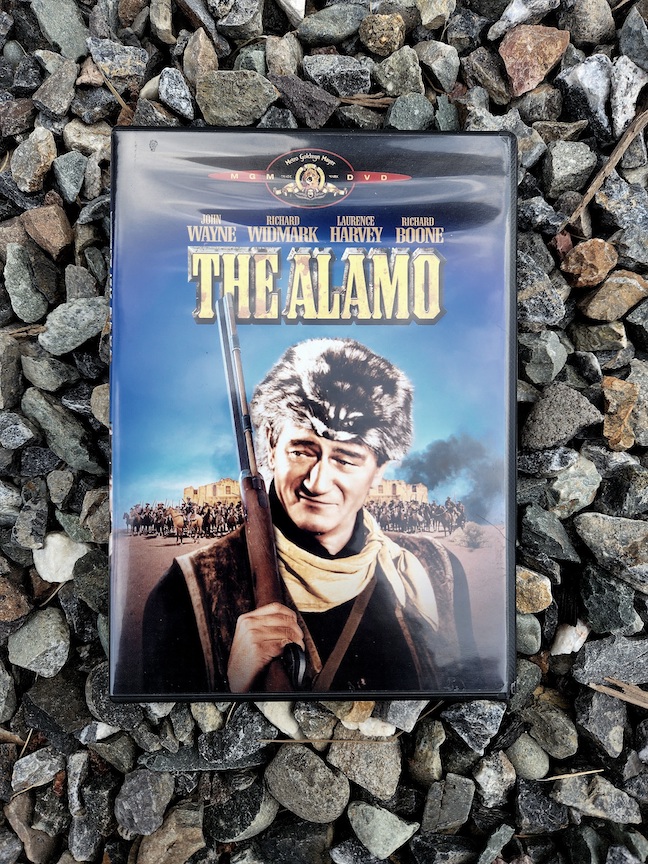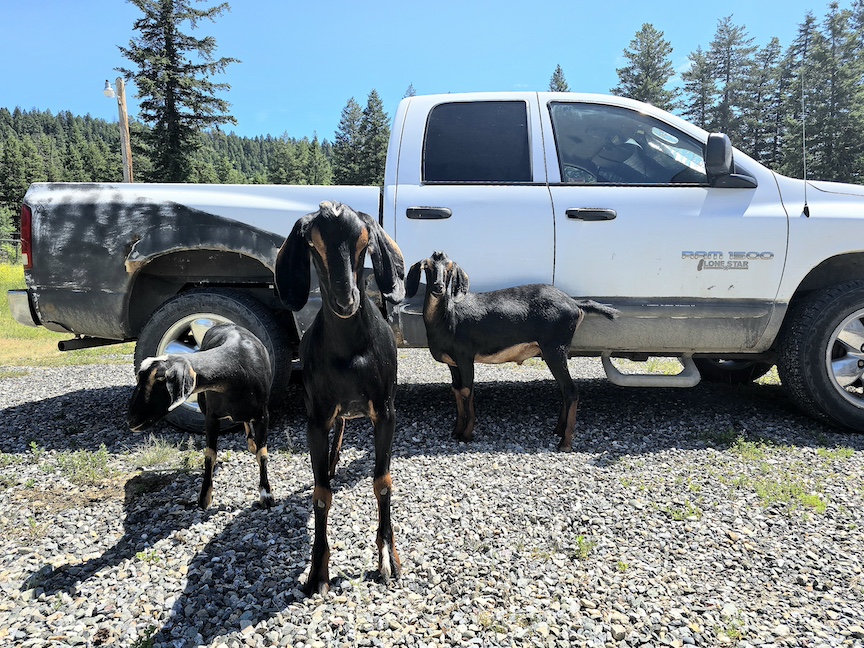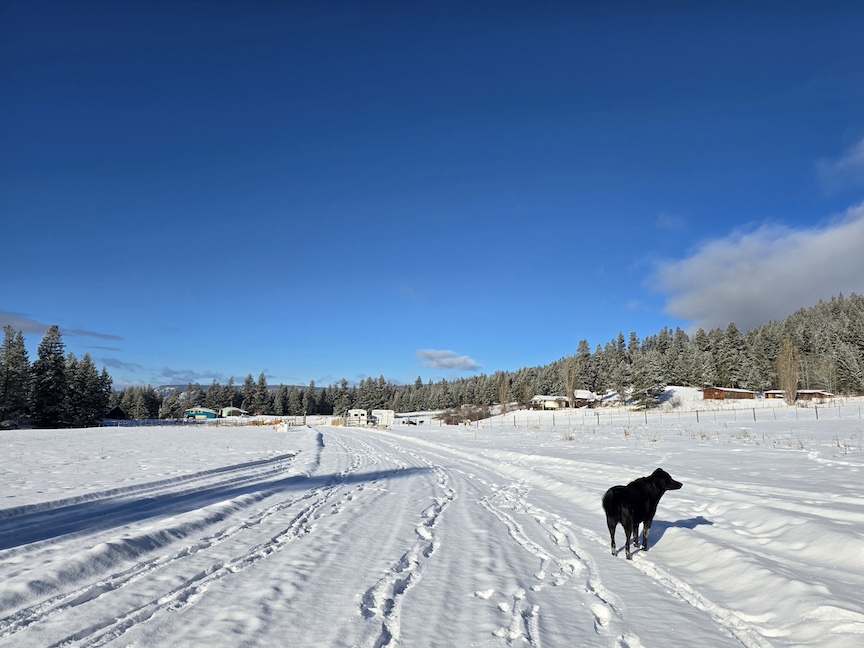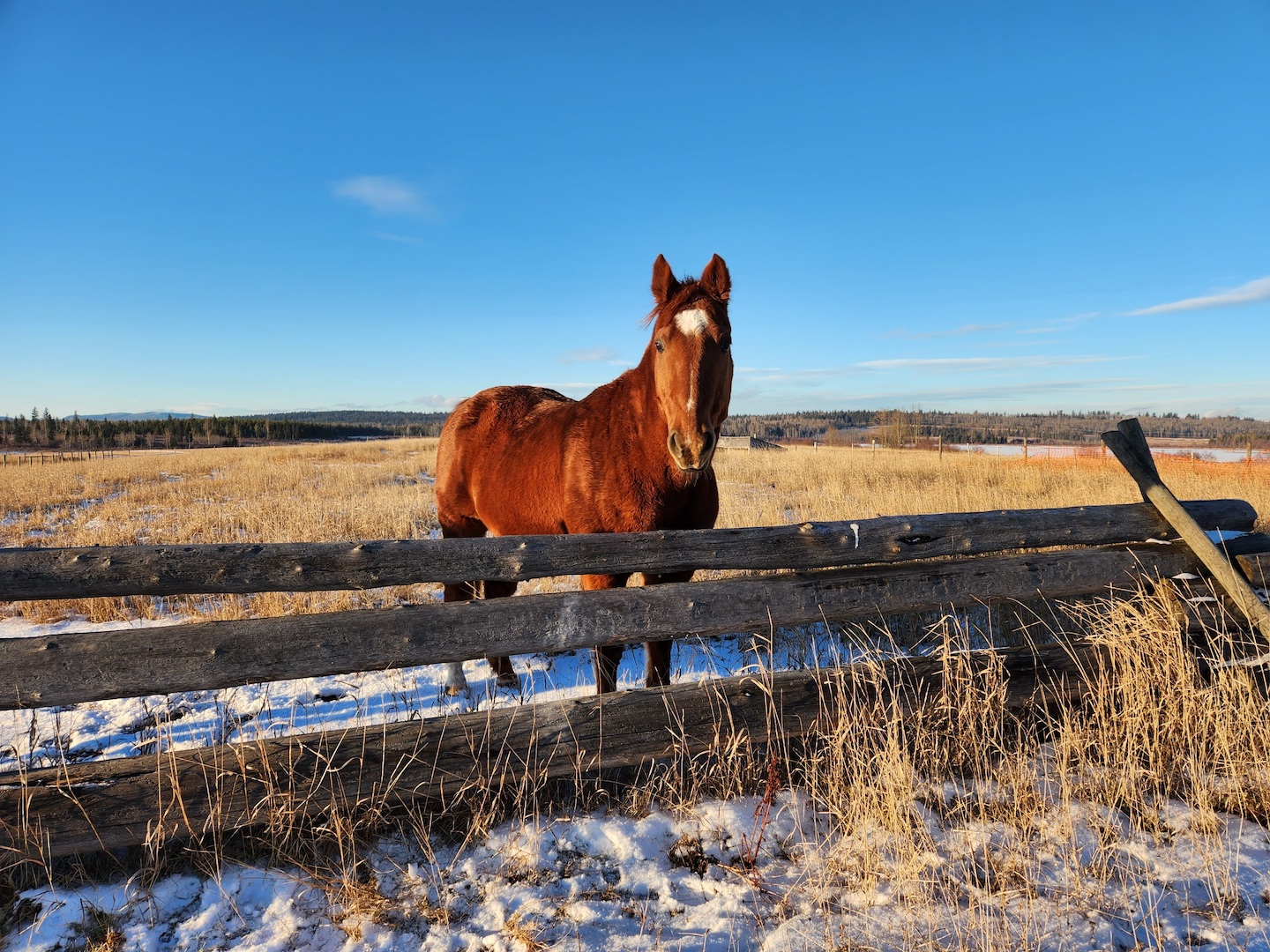Starring: John Wayne, Richard Widmark, Laurence Harvey, Frankie Avalon
Director: John Wayne
Released: 1960
Mood: If you really really love Texas and John Wayne and have a lot of time on your hands.
I’m about to piss off a lot of John Wayne fans, and possibly a lot of Texans, but holy crap… The Alamo is the most delusional and cheerfully self-indulgent movie I’ve seen this year.
It’s not a bad film by any standards. In fact, the production quality is excellent, and some of the acting is quite good. I do not hate this movie! But I did roll my eyes through much of its hefty two-hour-and-forty-five-minute runtime. Maybe that’s why when I bought it from a thrift store, it was still in its original plastic. Maybe the previous owner read some online reviews and didn’t bother.
There just are SO MANY creative choices here that I don’t understand, which prevented it from being worth its budget and cast. Let’s get right into it.

The Alamo is a heavily dramatized version of the infamous 1836 Battle of the Alamo. I’ll get into the historical inaccuracy in a minute, but here’s the John Wayne movie version of events.
Texas was part of Mexico. Texians, aka recently immigrated Americans, felt oppressed by the Mexican government. Mexico sent General Santa Anna with an army to sort things out.
Santa Anna’s purpose is unclear in the movie, since the script removed the context of Texians rebelling against Mexico by continuing with slavery and killing all Mexican troops in the state, or even a clear explanation of the recent changes to the Mexican government and its direct impact on Texas. All you get is that Mexico is bad, and a long speech from Davy Crockett (John Wayne) about the meaning of the word ‘republic’ – one of many points in the movie where the script is heavy on the “good vs. evil” talk and doesn’t bother hiding its anti-communist rhetoric.
Anyway. Knowing the path of the Mexican army’s march, a smallish group of around 100 rebels had set up camp at the broken-down Alamo Mission. This group was led by Col. William Barrett Travis (Laurence Harvey) and Jim Bowie (Richard Widmark), and joined by Davy Crockett (John Wayne) and his adorable sidekick, Smitty (Frankie Avalon) – plus a group of coonskin-cap-wearing Tennesseeans who get so much screen time you’d think the battle was actually between Tennessee and Mexico.
Santa Anna’s troops arrived. Much battle ensued. To this day, there are severe arguments over what actually took place.
![]()
I’m not going to get into a fight with anyone over the facts of the Alamo, because none of us were there. I’ll trust historians, because that’s literally their job. And according to historians, this movie doesn’t show things as they actually happened. Let me get the key changes out of the way:
- Jim Bowie and Davy Crockett weren’t buddies before the battle started – Bowie was already there when Crockett arrived, not long before the battle began
- Bowie was supposed to be huge (6′ compared to Crockett’s 5’8), but because nobody can be taller than John Wayne in a picture he’s depicted as smaller
- Bowie didn’t fight in the battle, he was severely ill in bed at the Alamo and only got up once a day during the siege to boost morale
- A sweet teenage boy wasn’t sent on horseback to take a message seeking reinforcements, it was a group of three men including Crockett – but obviously it looked better to have John Wayne stay in the battle
- Considered an early stage of the Civil War, a root cause of the battle was Texians wanting to keep the freedom to let Americans immigrate into Texas (then part of Mexico, which had recently decided to close its borders against Americans), and to keep importing and owning slaves (Mexico had abolished slavery)
- It’s never mentioned that Jim Bowie was a slave trader who smuggled slaves into the country long after slavery was abolished, and was fighting to keep up his family business of slave smuggling, so there is NO way that he would have compassionately freed his slave mid-battle
- It wasn’t all white people at the Alamo – there were slaves among the fighters, and lots of Tejanos fighting against the new dictatorship (they were later whitewashed out of the popular story to vilify Mexicans)
- Davy Crockett didn’t have a Mexican love interest! WHY did they need to cram a fake romantic storyline into this bloated script?!
Okay now. For the sake of not tackling too many issues in one review, let’s put ourselves in the mindset of late 1950s, post-WWII Hollywood. Everyone loves Westerns. Everyone loves America. And everyone loves John Wayne!
With that in mind, this version of the Alamo seems like the perfect story to tell on the big screen, with Wayne front and centre. You have two American legends, Davy Crockett and Jim Bowie, putting their lives on the line for freedom and honour and all that good patriotic stuff.
Wayne is actually quite good in The Alamo. His version of Crockett has a much bigger role in the events than Bowie and Travis, which seems tailored to Wayne’s star power. He’s also got some painfully long monologues that take you out of the period, but so does almost everyone. You can tell that he’s putting his heart into this character.
- Fun Fact #1: Wayne actually didn’t want to play Crockett, he wanted to play Sam Houston so he could focus on directing. But the studio forced him to take a role with top billing to drive box office sales. Wayne had already financed a good portion of the production so the movie could be made his way, including getting second mortgages on his houses and using his vehicles to get loans.
Laurence Harvey is a standout as Col. Travis. Apparently Wayne wanted a touch of British class in his movie, which is why he chose Harvey. Regardless of the reason, Harvey’s performance is powerful and quite memorable.
Frankie Avalon’s accent comes and goes, but he’s actually fun to watch. He’s got that same eager-beaver energy as Burt Ward in the ’60s Batman TV series. Wayne apparently only cast Avalon because another teen idol, Ricky Nelson, was such a successful box office draw for Rio Bravo and he wanted to use a similar tactic for this movie. But he ended up complimenting Avalon’s skill and keeping all of his scenes in the final cut.
Richard Widmark as Jim Bowie is mostly just surly. Apparently Widmark tried to quit the project, thinking he was miscast as Bowie and not getting along with Wayne due to their deeply opposing political views, so maybe he was just riding around being Richard Widmark not wanting to be there.
Chill Wills, on the other hand, IS there – unfortunately for everyone. He’s doing his schtick, delivering a lot of unnecessary comedy. It doesn’t work for this or any version of the Alamo.
- Fun Fact #2: Wills launched a tacky AF campaign for a Best Supporting Oscar and somehow got nominated (Wayne felt Harvey should have got the nom). Wills said in his print ad campaign, “The Alamo cast are praying harder than the real Texans prayed for their lives at the Alamo for Chill Wills to win the Oscar,” which pissed off a LOT of people for good reason. He didn’t win.
- Fun Fact #3: Sammy Davis Jr. wanted the tiny part of the Black slave, as a chance to break out from being typecast as only a song-and-dance guy. But because he was dating a white girl, Wayne felt the investors might withdraw so he was not cast. It’s too bad, because Davis went on to do many guest spots in popular ‘60s Western TV shows, and was actually a gifted gunslinger – and was one of the fastest draws in Hollywood.
![]()
What I don’t get about the acting and script of The Alamo is why Wayne and his favourite screenwriter, James Edward Grant, felt like they had to camp up this story. There is so much awkward comedy, that stupid romantic subplot that could have saved us all at least 20 minutes, and so much time spent on long-winded dialogue, that it takes away from the good stuff.
If you’re telling the version of the Alamo where it’s about American freedom, dying in a brave battle, and you have this epic budget and a gazillion actors (7000 extras, 1500 horses and 400 Texan longhorn cattle), why not focus on THE BATTLE? It’s definitely not the vibe I expected from John Wayne doing his take on this iconic piece of American history.
The battle scenes are great. Like, every time these guys are fighting, whether it’s fist fights or skirmishes or the siege itself, it’s fantastic footage. The set took two years to build, was painstakingly created with attention to historic detail (unlike the script), and has since been used in over 100 other Westerns.
But the whole thing feels too long, too fake, and the score keeps shoving this upbeat story from behind and it just doesn’t work.
That’s why despite being the fifth highest-grossing movie of 1960, The Alamo didn’t make back its budget. It took Wayne over a decade to recoup his personal investment, which only happened when the TV rights were bought in 1971.
If you want to watch a great John Wayne Western that’s intentionally fun, stick with The War Wagon. If you want a great John Wayne Western war movie, go with Rio Grande. Basically you can throw a dart at any John Wayne DVD box set and do a lot better than The Alamo.


